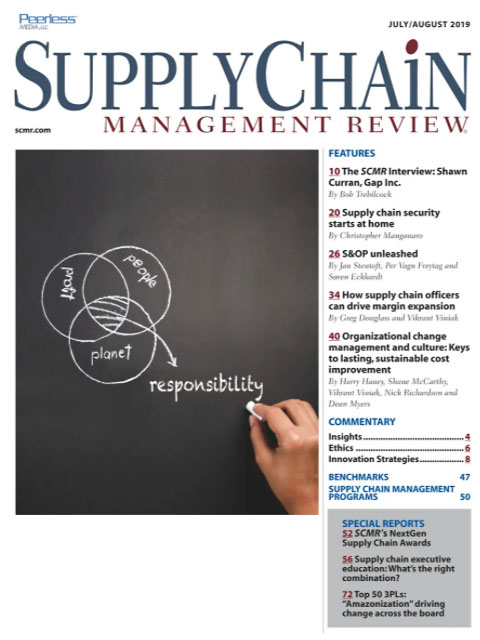Sorry, but your login has failed. Please recheck your login information and resubmit. If your subscription has expired, renew here.
July-August 2019
If you’re a long-time reader of Supply Chain Management Review, you’re familiar with Larry Lapide’s “Insights” column. Typically, Larry is writing about the many facets of planning, but occasionally, he takes on a provocative topic. One year, he questioned whether it was necessary to be a Top 25 supply chain leader, especially if in your industry, good enough gets the job done. Browse this issue archive.Need Help? Contact customer service 847-559-7581 More options
Katie Date is the manager of corporate and SCALE network outreach at the MIT Center for Transportation and Logistics. She leads the MIT CTL Women in Supply Chain Initiative, which is exploring ways to address gender challenges in supply chain management through education and outreach initiatives targeted at mid-career supply chain professionals. She can be contacted at [email protected].
Efforts to encourage more women to become supply chain practitioners and correct the gender imbalance that has long plagued the profession are starting to bear fruit. However, there is one area where progress is lacking: The leadership level. Research indicates that gender-balanced enterprises tend to be more productive and innovative.
Also, female supply chain leaders provide role models who can inspire women to enter the profession and climb the career ladder. How can the supply chain management function entice more women to join its leadership ranks? This was one of the questions discussed at the Women in Supply Chain Summit: Achieving Balance in SCM this past March in Boston.
The event was organized by the MIT CTL Women in Supply Chain Initiative and hosted by lifestyle footwear and apparel brand Converse. The female practitioners who participated in the event provided some innovative approaches to changing the complexion of supply chain’s upper echelon.
Progress—but not at the top
The 2019 AWESOME/Gartner Women in Supply Chain survey* summary reports a modest improvement in gender diversity in supply chain management. Women currently make up 39% of the supply chain workforce on average, according to the survey results. Gartner surveyed 165 supply chain professionals and their companies’ goals to improve gender diversity.

This complete article is available to subscribers only.
Log in now for full access or start your PLUS+ subscription for instant access.
SC
MR
Sorry, but your login has failed. Please recheck your login information and resubmit. If your subscription has expired, renew here.
July-August 2019
If you’re a long-time reader of Supply Chain Management Review, you’re familiar with Larry Lapide’s “Insights” column. Typically, Larry is writing about the many facets of planning, but occasionally, he… Browse this issue archive. Access your online digital edition. Download a PDF file of the July-August 2019 issue.Katie Date is the manager of corporate and SCALE network outreach at the MIT Center for Transportation and Logistics. She leads the MIT CTL Women in Supply Chain Initiative, which is exploring ways to address gender challenges in supply chain management through education and outreach initiatives targeted at mid-career supply chain professionals. She can be contacted at She can be contacted at [email protected].
Efforts to encourage more women to become supply chain practitioners and correct the gender imbalance that has long plagued the profession are starting to bear fruit. However, there is one area where progress is lacking: The leadership level. Research indicates that gender-balanced enterprises tend to be more productive and innovative.
Also, female supply chain leaders provide role models who can inspire women to enter the profession and climb the career ladder. How can the supply chain management function entice more women to join its leadership ranks? This was one of the questions discussed at the Women in Supply Chain Summit: Achieving Balance in SCM this past March in Boston.
The event was organized by the MIT CTL Women in Supply Chain Initiative and hosted by lifestyle footwear and apparel brand Converse. The female practitioners who participated in the event provided some innovative approaches to changing the complexion of supply chain's upper echelon.
Progress—but not at the top
The 2019 AWESOME/Gartner Women in Supply Chain survey* summary reports a modest improvement in gender diversity in supply chain management. Women currently make up 39% of the supply chain workforce on average, according to the survey results. Gartner surveyed 165 supply chain professionals and their companies' goals to improve gender diversity.
 SUBSCRIBERS: Click here to download PDF of the full article.
SUBSCRIBERS: Click here to download PDF of the full article.
SC
MR


Latest Supply Chain News
- Survey reveals strategies for addressing supply chain, logistics labor shortages
- Israel, Ukraine aid package to increase pressure on aerospace and defense supply chains
- How CPG brands can deliver on supplier diversity promises
- How S&OP provides the answer to in-demand products
- AI, virtual reality is bringing experiential learning into the modern age
- More News
Latest Podcast

 Explore
Explore
Business Management News
- Survey reveals strategies for addressing supply chain, logistics labor shortages
- How CPG brands can deliver on supplier diversity promises
- How S&OP provides the answer to in-demand products
- AI, virtual reality is bringing experiential learning into the modern age
- Tips for CIOs to overcome technology talent acquisition troubles
- There is still work to do to achieve supply chain stability
- More Business Management
Latest Business Management Resources

Subscribe

Supply Chain Management Review delivers the best industry content.

Editors’ Picks






